
Mercury is the first and the smallest planet in our solar system. It is also the closest planet to Earth. Like the other three terrestrial planets, Mercury contains a core surrounded by a mantle and a crust.
But unlike any other planet, Mercury’s core makes up a larger portion of the planet. It was the analysis from the MESSENGER mission that tells: Mercury’s core is solid.
It has long been known that Mercury’s core composition is made of liquid metal. The core itself is about 3,600 km across. Surrounding that is a 600 km thick mantle. And around that is the crust, which is believed to be 100-200 km thick. The crust is known to have narrow ridges that extend for hundreds of kilometers.
This large core has long been one of the most intriguing mysteries about Mercury.
Why does Mercury have a large core?
A new study reveals that the sun’s magnetism is the reason. William McDonough, a professor of geology at the University of Maryland, and Takashi Yoshizaki from Tohoku University developed a model that shows- the sun’s magnetic field influences the density, mass, and iron content of Mercury’s core.
McDonough said, “The four inner planets of our solar system—Mercury, Venus, Earth, and Mars—are made up of different proportions of metal and rock. A gradient in which the metal content in the core drops off as the planets get farther from the sun. Our paper explains how this happened by showing that the sun’s magnetic field controlled the distribution of raw materials in the early forming solar system.”
According to this newly developed model, during the early formation of the solar system, when a swirling dust storm and gas encircled the sun, iron’s grain was drawn toward the center by the sun’s magnetic field. At the time of planet formation from clumps of that dust and gas, planets nearer to the sun consolidated more iron into their centers than those farther away.
Scientists also found that the density and proportion of iron in the planet’s core correlate with the strength of the magnetic field around the sun during planetary formation.
Scientists say, “Future studies on understanding the composition of rocky planets should consider the sun’s magnetism as an important factor.”
Existing models on planetary formation were used to determine the speed at which gas and dust were pulled into the center of our solar system during its formation. The magnetic field that the sun would have generated as it burst into being and calculated how that magnetic field would draw iron through the dust and gas cloud.
As the early solar system began to cool, dust and gas that were not drawn into the sun started to clump together. The clumps closer to the sun would have been exposed to a stronger magnetic field and thus would contain more iron than those farther away from the sun. As the clumps coalesced and cooled into spinning planets, gravitational forces drew the iron into their core.
When this model was applied to calculations of planetary formation, it revealed a gradient in metal content and density that corresponds perfectly with what scientists know about the planets in our solar system.
This new comprehension of the role magnetism plays in planetary formation creates a twist in the study of exoplanets.
The next steps in this work will be for scientists to find another planetary system like ours—one with rocky planets spread over wide distances from their central sun. If the density of the planets drops as they radiate out from the sun the way it does in our solar system, researchers could confirm this new theory and infer that a magnetic field influenced planetary formation.
Journal Reference:
- William F. McDonough et al., Terrestrial planet compositions controlled by accretion disk magnetic field, Progress in Earth and Planetary Science (2021). DOI: 10.1186/s40645-021-00429-4
Continue reading Mystery solved: Why Mercury has a big iron core? on Tech Explorist.
0 comments:
Post a Comment